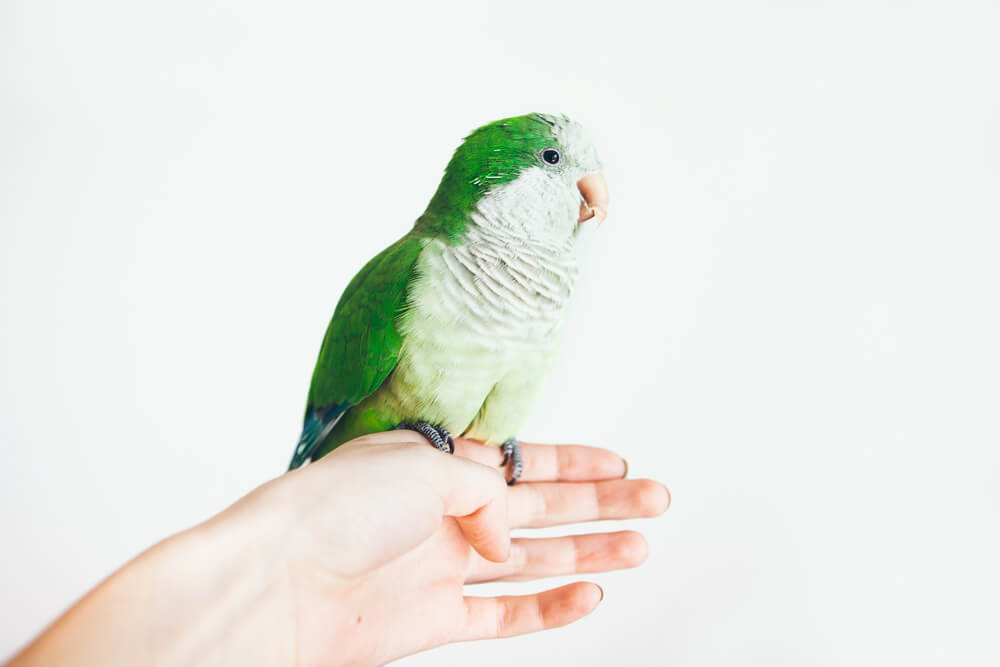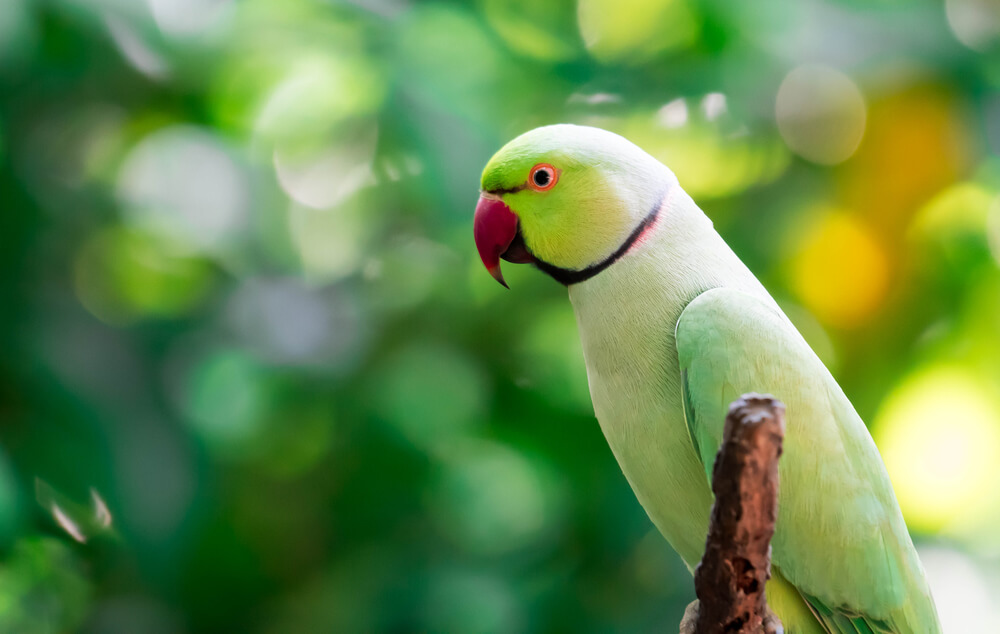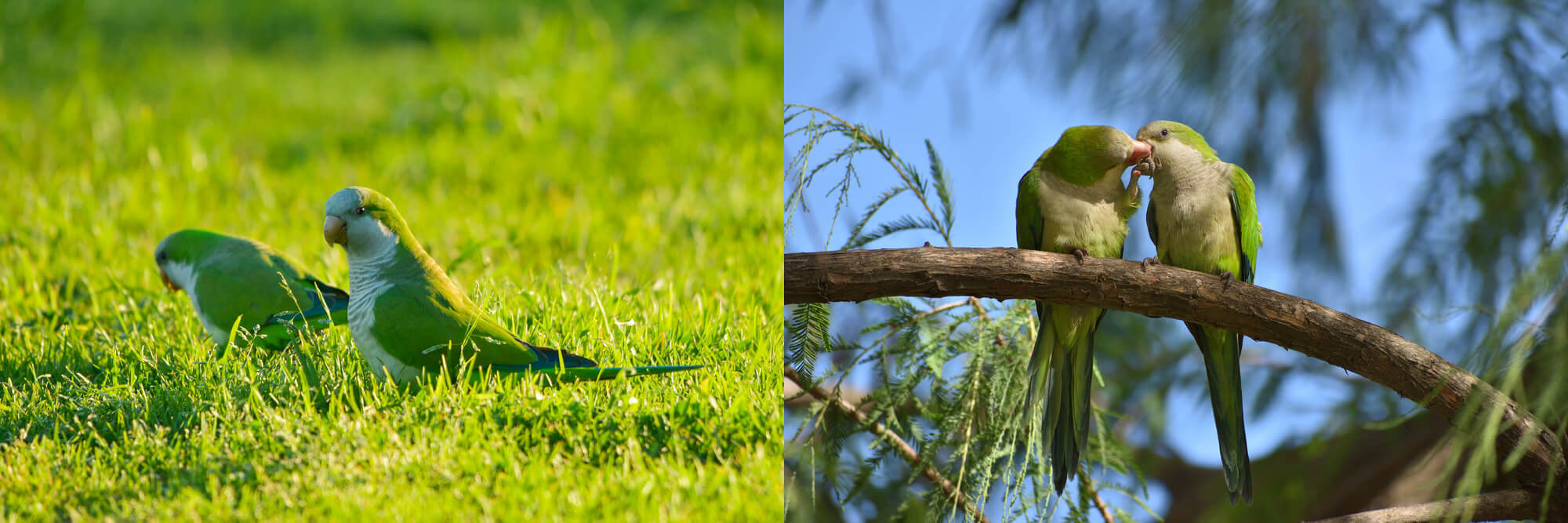If you are considering adding a feathered friend to your family, you may be wondering which bird is the best fit for you. Two popular options are the Quaker parrot vs Indian ringneck.
Both birds are known for their beautiful plumage, intelligence, and vocal capabilities. However, there are some key differences between the two that you should consider before making your decision.
The Quaker parrot, also known as the Monk parakeet, is a small to medium-sized parrot that is native to South America. They are known for their playful and curious personalities, as well as their ability to mimic human speech.
The Indian ringneck, on the other hand, is a larger parrot that is native to the Indian subcontinent. They are known for their stunning colors and their ability to perform tricks.
When comparing the Quaker parrot and the Indian ringneck, there are several factors to consider, including size, personality, and care requirements.
By understanding the differences between the two, you can make an informed decision about which bird is the best fit for you and your family.
Key Takeaways
- The Quaker parrot and Indian ringneck are both popular pet birds known for their beauty, intelligence, and vocal capabilities.
- The Quaker parrot is a smaller, playful bird that is known for its ability to mimic human speech, while the Indian ringneck is a larger, more colorful bird that is known for its ability to perform tricks.
- When choosing between the two, it is important to consider factors such as size, personality, and care requirements to determine which bird is the best fit for you and your family.
Quaker Parrot vs Indian Ringneck
Overview of Quaker Parrot

When it comes to choosing a pet bird, the Quaker Parrot is a popular choice. In this section, we will provide you with an overview of the Quaker Parrot, including its origins, characteristics, behavior, diet, and health needs.
Origins
The Quaker Parrot, also known as the Monk Parakeet, is native to South America. It was first introduced to the United States in the 1960s as a pet bird.
However, due to their hardy nature and adaptability, many Quaker Parrots escaped or were released into the wild.
Today, Quaker Parrots can be found in many parts of the United States, particularly in the warmer states.
Characteristics
Quaker Parrots are small to medium-sized birds, typically measuring around 11-12 inches in length. They have a distinctive green plumage, with a grey face and breast.
Their beaks are strong and hooked, which they use to crack open nuts and seeds. Quaker Parrots are also known for their expressive eyes, which can convey a range of emotions.
Behavior
Quaker Parrots are highly social birds and thrive on interaction with their owners. They are intelligent and can be trained to perform a range of tricks and behaviors.
Nevertheless, they can also be quite vocal and may not be suitable for apartment living. Quaker Parrots are also known for their nesting behavior, and they will construct elaborate nests out of sticks and other materials.
Diet and Health Needs
Quaker Parrots require a varied diet that includes a mix of seeds, fruits, vegetables, and pellets. They also need access to fresh water at all times.
In terms of health needs, Quaker Parrots require regular veterinary check-ups to ensure that they are in good health.
They are prone to a range of health problems, including obesity, respiratory infections, and feather plucking.
Quaker Parrots make excellent pets for those who are willing to provide them with the attention and care that they require.
With their intelligence, social nature, and distinctive plumage, they are sure to make a wonderful addition to any household.
Overview of Indian Ringneck

If you are considering adding a parrot to your family, the Indian Ringneck is a popular choice. Here is an overview of this beautiful bird, including its origins, characteristics, behavior, diet, and health needs.
Origins
The Indian Ringneck, also known as the Rose-Ringed Parakeet, is native to India and surrounding areas. It is a medium-sized parrot, with males typically measuring around 16 inches in length and females around 14 inches.
Characteristics
One of the most striking features of the Indian Ringneck is its beautiful plumage. Males have a bright green body, with a distinctive black and pink ring around their necks, while females have a less pronounced ring and a duller green body.
Both sexes have long tails and bright red beaks.
Indian Ringnecks are also known for their intelligence and ability to mimic sounds and words. They are social birds and enjoy interacting with their owners.
Behavior
Indian Ringnecks are active birds and require plenty of space to move around and play. They are also known for their loud calls, so they may not be the best choice for apartment living.
If you are considering an Indian Ringneck, it is important to note that they can be somewhat independent and may not always want to be handled or cuddled.
They do, however, enjoy spending time with their owners and can be trained to do tricks and perform other behaviors.
Diet and Health Needs
Like all parrots, Indian Ringnecks require a varied diet that includes a mix of seeds, fruits, vegetables, and other foods.
They also need plenty of fresh water and access to a cuttlebone or other source of calcium.
In terms of health needs, Indian Ringnecks can be prone to a number of conditions, including feather plucking and respiratory infections.
Regular veterinary check-ups and a clean, well-maintained living environment are essential to keeping your bird healthy and happy.
Overall, the Indian Ringneck is a beautiful, intelligent bird that can make a wonderful addition to the right family.
If you are considering one, be sure to do your research and provide the right environment, diet, and care to ensure your bird thrives.
Comparison of Quaker Parrot and Indian Ringneck

When it comes to choosing a pet bird, both Quaker Parrots and Indian Ringnecks are excellent choices.
However, there are some key differences between these two species that you should consider before making your decision.
In this section, we will compare Quaker Parrots and Indian Ringnecks in terms of their physical, behavioral, dietary, and health differences.
Physical Differences
Quaker Parrots are smaller in size compared to Indian Ringnecks. On average, Quaker Parrots are around 11 inches long, while Indian Ringnecks can grow up to 16 inches.
Quaker Parrots have a green body with grey feathers on their head and chest. In contrast, Indian Ringnecks have a variety of colors, including green, blue, yellow, and white.
Behavioral Differences
Quaker Parrots are known for their playful and social nature. They are also highly intelligent and can be trained to do various tricks.
On the other hand, Indian Ringnecks are more independent and can be aloof at times. They are also known for their talking ability and can learn to mimic human speech easily.
Dietary Differences
Both Quaker Parrots and Indian Ringnecks have similar dietary requirements. They need a balanced diet consisting of fruits, vegetables, seeds, and pellets.
Yet, Quaker Parrots tend to be more prone to obesity, so it is important to monitor their food intake and provide them with regular exercise.
Health Differences
Both Quaker Parrots and Indian Ringnecks are generally healthy birds. Nonetheless, Quaker Parrots are more prone to certain health issues, such as obesity, fatty liver disease, and respiratory infections.
Indian Ringnecks are more prone to feather plucking and behavioral issues.
Both Quaker Parrots and Indian Ringnecks are great pet birds, but they have their own unique characteristics and requirements. Consider your lifestyle and preferences before making your decision.
Choosing the Right Pet

When it comes to choosing the right pet, there are several factors to consider. Both Quaker Parrots and Indian Ringnecks are popular pet bird species, but which one is right for you?
Here are some things to keep in mind when making your decision.
Considerations for Quaker Parrot
Quaker Parrots, also known as Monk Parakeets, are known for their playful and affectionate personalities. They are intelligent birds that can learn to mimic sounds and even words.
Here are some things to consider if you’re thinking about getting a Quaker Parrot:
- Noise level: Quaker Parrots can be noisy, especially during their morning and evening chatter. If you live in an apartment or have close neighbors, this might not be the best pet for you.
- Dietary needs: Quaker Parrots need a varied diet that includes fresh fruits and vegetables, as well as high-quality pellet food. They also enjoy nuts and seeds as treats.
- Cage size: Quaker Parrots need a large cage that allows them to spread their wings and move around freely. A cage that is at least 18 inches wide, 18 inches deep, and 24 inches tall is recommended.
- Lifespan: Quaker Parrots can live up to 25 years in captivity, so they are a long-term commitment.
Considerations for Indian Ringneck
Indian Ringnecks are known for their strikingly beautiful plumage and their intelligence. They are also great talkers and can learn to mimic words and sounds.
Here are some things to consider if you’re thinking about getting an Indian Ringneck:
- Noise level: Indian Ringnecks can also be noisy, especially during their morning and evening chatter. If you live in an apartment or have close neighbors, this might not be the best pet for you.
- Dietary needs: Indian Ringnecks need a varied diet that includes fresh fruits and vegetables, as well as high-quality pellet food. They also enjoy nuts and seeds as treats.
- Cage size: Indian Ringnecks need a large cage that allows them to spread their wings and move around freely. A cage that is at least 24 inches wide, 24 inches deep, and 36 inches tall is recommended.
- Lifespan: Indian Ringnecks can live up to 30 years in captivity, so they are also a long-term commitment.
Ultimately, the decision to get a Quaker Parrot or an Indian Ringneck comes down to your personal preferences and lifestyle.
Both birds require a lot of attention and care, so be sure you’re ready for the commitment before bringing one home.
Conclusion
In conclusion, both the Quaker Parrot and Indian Ringneck have their own unique characteristics that make them great pets. It ultimately depends on your personal preferences and lifestyle.
Here are some key points to consider when deciding between the two:
Quaker Parrot
- Known for their playful and affectionate personalities
- Can learn to mimic sounds and words
- Requires plenty of toys and social interaction to prevent boredom and potential behavioral issues
- Can be loud at times, especially during breeding season
- Generally less expensive than Indian Ringnecks
Indian Ringneck
- Beautiful and striking plumage, with a variety of colors available
- Can be more independent and less demanding of attention than Quaker Parrots
- Known for their intelligence and ability to learn tricks
- Can be more vocal and noisy than Quaker Parrots, especially during the breeding season
- Generally more expensive than Quaker Parrots
Ultimately, the decision between a Quaker Parrot and an Indian Ringneck comes down to your personal preferences and lifestyle.
Consider factors such as noise level, cost, and attention requirements when making your decision. With proper care and attention, both of these birds can make wonderful and rewarding pets.
Frequently Asked Questions
Do Quaker parrots make good pets?
Quaker parrots make great pets for those who are willing to commit time and effort to their care. They are social birds that enjoy interacting with their owners and can form strong bonds.
They are also intelligent and playful, which makes them entertaining companions.
Are Quaker parrots good talkers?
Quaker parrots are known for their ability to mimic human speech, although not all individuals will learn to talk.
With proper training and socialization, they can develop an impressive vocabulary and clarity of speech.
However, it is important to remember that not all Quaker parrots will be talkers, and their ability to talk may vary from bird to bird.
Are Quaker parrots aggressive?
Quaker parrots can be territorial and protective of their space, which may lead to aggressive behavior toward other birds or people. However, with proper socialization and training, this behavior can be managed.
It is important to note that not all Quaker parrots will display aggressive behavior, and each individual bird should be evaluated on its own personality.
Are Indian ringnecks aggressive?
Indian ringnecks can be territorial and may display aggressive behavior towards other birds or people.
Regardless, with proper socialization and training, this behavior can be managed. It is important to note that not all Indian ringnecks will display aggressive behavior, and each individual bird should be evaluated on its own personality.
Indian Ringneck pros and cons
Indian ringnecks are intelligent and playful birds that can make great pets for experienced bird owners. They are known for their ability to mimic human speech and can develop a large vocabulary with proper training.
Nevertheless, they can be territorial and may display aggressive behavior towards other birds or people.
Also, they can be noisy and require a lot of attention and socialization.
Are Indian ringnecks one-person birds?
Indian ringnecks can form strong bonds with their owners, but they are not necessarily one-person birds.
With proper socialization and training, they can learn to interact with multiple people and may even enjoy the company of other birds.
Yet, they may still display a preference for their primary caregiver.








